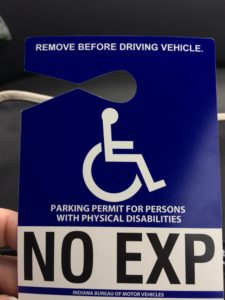
This is how snow that has been plowed and driven over in a parking lot looks to me. No amount of light helps me see the difference. (I have no such problems on unplowed snow, where I can recognize the disturbance caused by tire tread, footsteps, or even wind.)
Years ago, I was very reticent to get a disability parking placard because I felt that to get such a thing would be to give up all hope on the possibility of my sight returning. After a winter full of navigating icy and snowy parking lots—of rapid heartbeat, straining eyes, and treacherous footing as the high winter winds buffeted me and tried to push me from my path, and of wanting, but being unable, to call out to my husband to slow down and wait for me because in this situation I could not walk as quickly and surefootedly as under normal conditions, all of my effort being so focused on the gauntlet between our car and the store—I finally gave in and got a temporary placard, which I was told I had to have before I could get a permanent placard.
By the expiration date of that placard, however, I was a mother and had a strange schedule that made it difficult to get to the BMV (known as the DMV in some states) to renew it during normal hours, so I let it slip. I called once to learn what was required: physically going to a BMV to get the permanent placard. And I kept intending to go, but because I really need it only in the winter, when I can’t distinguish between snow and ice in plowed parking lots, its importance kept slipping my mind. Once or twice a year, when we were out in a parking lot and I was forced to cautiously and painstakingly navigate the islands of ice and snow, I would promise myself that I was going to get a new placard. But every year, the weather got warmer, the parking lots cleared, and I forgot, because it required a bit of extra effort out of me—effort that I just didn’t have to spare with two very young kids.
This December, however, we had to go to the BMV for another reason, so I inquired about getting the placard. More effort was required than I had expected. My temporary placard had been expired for so long that I once again had to go through the entire process of myself and a doctor completing a form attesting to my disability and then me taking the form in to the BMV. Why this year was any different than previous years and I went through the extra effort, I honestly don’t know. I’d like to say it’s because my children require slightly less of my mental reserves than before, or that I had been restructuring my life in such a way that I had finally reached a point where this rather small effort didn’t seem bothersome, or that I had finally—finally!—worked through the mental blocks that kept me from wanting this little bit of help. I can’t say it’s any of those. Maybe it’s all of those. Or none.
What I can say, however, is that about a month after initially trying to get the placard, and almost nine years after originally being declared legally blind, I finally got my permanent disability placard. The humor (irony?) was not lost on me that I finally got it in the first few hours of a winter storm—which was expected to be the worst winter storm that we’d had in five years—requiring me to wade through several of inches of snow to get to our car at our house and then through the parking lot at the BMV.

Maybe that was why, when I finally held the new permanent placard, I felt at peace, even a little pleased. I remember the feeling only because it was so unexpected—I was pleased that I, a capable thirty-eight-year-old mother of two, had a temporary disability placard?! I’ve had time to really sink into the feelings now, and I’ve been able to recognize that this was less a feeling of being pleased than a feeling of rightness, of finally having given over to something I should have given over to long ago. Inexplicably, I catch myself sneaking glimpses of it sometimes, as you sometimes do with a new toy you’ve long desired and waited for, hardly able to believe you finally have it. Occasionally in these glimpses, I do still feel something that may be a tiny bit of sadness—maybe even melancholy—but that I think is likely more akin to an almost piquant nostalgia rather than the fresh new pain of recent defeat.
All in all, a surprising number of emotions have been brought up by this event, by this tiny little placard. Surprised as I have been by them, I’ve meditated on the situation and, in those meditations, have come to realize that I actually experience several waves of emotion in quick succession. My initial response to seeing the tag is a twinge starting in my heart and running straight down into my bowels. That’s heartache, disappointment, and fear. Then come the tears, which are first a reaction to and then a release of the fear. Next is (re)realization of the fact that I have a disability. Then a resistance to admitting that I have a disability. Mixed in with all of these stages so far is fear of other people’s responses and judgment. (We’ve all heard stories of—or perhaps even been—those people who see a person who looks “normal” or “healthy” emerge from a vehicle with a disability hangtag or plate and then judge that the healthy-looking person has no disability and is using a disability plate for their own momentary advantage.)
Then comes the relief of knowing that, so long as the handicapped parking spots at the store have not been all filled up by other people, the next time I have to go to the store during or after a winter storm, I may have to endure only 40 feet—rather than 80 or 120—of that perilous, nerve-wracking crossing.
Then, finally, comes the calm acceptance that this placard will not prevent such a situation from occurring again but that sometimes—just sometimes—it will make my life just a little easier and that I need not feel guilty about having a little bit of help, a little more ease, in my life. Because, as the placard says, “NO EXP.” This placard has no expiration date because my disability has no expiration date, no matter how much I may want it to.

Is there still a possibility that my retinas will heal—either spontaneously or very, very gradually—and my vision will return fully? Science puts the odds at almost zero. I still struggle with this, because in 2009, I heard that voice so clearly and so surely telling me that my vision would be restored. On the one hand, I tell myself that I must maintain faith because my vision has not been restored to what it was before the IIH. On the other hand, I also tell myself that my visual acuity is nearly what it was before the IIH and is far better than the experts expected it to be, so even though I still have dozens of blind spots and incredibly limited peripheral vision, the promise has been fulfilled.
More than nine years after I first lost my vision and heard that promise, I still don’t know how to interpret that reassurance from the “other side.” Perhaps I never will. All I can do is live the best I can, making the best choices I can in every moment, based on what limited knowledge I have. Sometimes, that knowledge will be provided only by this physical realm, and sometimes, the knowledge from the physical realm will be informed and supplemented by Divine guidance. But no matter what choice I make, things will play out as they will play out, and there is no way to go back and change things. And in the end, isn’t that the very essence of faith—to trust that the Divine will always ensure that the Highest Good is the result, even when we are faced only with options that all seem equally shitty in the moment?
Maybe my vision is as good as it will ever get, or maybe it will be completely restored one day. But getting and using a permanent disability placard is not giving up faith, only refusing to suffer in or because of my faith. We are here in this life to learn, and though the nature of life on this planet and in this reality seems to be that hardship is the best trigger for our learning to begin, we grow and heal only when we accept and acknowledge the hardship as an opportunity to learn.
Hardship may be unavoidable in our lives, but suffering is entirely voluntary. My limited vision is a fact of my life as it currently is, and I suffer only if I try to remain in the past and live as I did before my loss of vision happened. We suffer only when we refuse to accept things the way they are and refuse to adapt accordingly.
My suffering in this situation came about because of a lack of faith, because I somehow thought that lessening my hardship by using a disability placard would result in my vision not being restored. Now, though, I understand that faith does not require suffering, but that my suffering was built on a lack of faith. Lessening my own hardship is not a rejection of my faith; it is simply acceptance of the way my life is in this moment and recognition that I alone can relieve my suffering.
***
Find Me Elsewhere on the Web
My Services
Do you want to know what message a particular spirit (for example, a spirit guide, angel, earth spirit, deceased loved one) has for you? Contact me.
Interested in knowing more about how the energies of the next twelve months will affect you directly? Purchase a personalized Year-Ahead Review.
Looking for healing? I offer distance Reiki sessions and other intuitive readings.
Leave a Reply
Your email is safe with me.